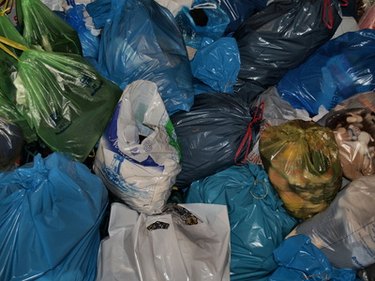
First introduced in the 1970s, plastic bags now make up one fifth of the bags handed out at the grocery store. Lightweight, sturdy and inexpensive, plastic bags are a convenient choice for both shoppers and store clerks. Made from a host of chemicals, they also create a variety of environmental problems. However, they are also easy to reuse and recycle.
Thermoplastic
Video of the Day
Plastic bags are made from low-density polyethylene (LDPE), a form of thermoplastic. Thermoplastics can be softened by heating, reshaped and then hardened by cooling. Typically thermoplastics are shaped into pellets, sheets, fibers, tubes or films before being molded into a variety of products.
Video of the Day
Components
Plastic is an organic substance consisting of large molecules called polymers. It is distilled from wood, coal, oil and even natural gas by chemicals such as hydrogen, nitrogen, oxygen and carbon. Other chemicals present in plastic may include chlorine, sulfur, silicone and fluorine. The polymers are made flexible and tough by the addition of a substance called a plasticizer. According to the Plasticisers Information Centre, there are about 300 types of plasticizer, and between 50 and 100 are currently in commercial use around the world. The most common types are phthalates which are derived from phthalic acid.
Advantages
Using plastic bags has many advantages over using paper bags. For instance, according to Earth 911, manufacturing plastic bags create 50 percent less greenhouse gas, 80 percent less waste and use 70 percent less energy than manufacturing paper bags. Plastic bags are also easier to recycle than paper. It takes up 91 percent less energy to recycle a pound of plastic than it takes to recycle an equal amount of paper. Modern plastic bags are mostly made from natural gas. When they are recycled, the energy stored in the plastic can be made into new products or recovered.
Disadvantages
For all their beneficial qualities, plastic bags create a variety of problems. As marine scientist David Barnes told "National Geographic." plastic bags often end up in the ocean where they starve and choke wildlife and form rafts that carry alien species around the world. Although they are highly reusable, millions of plastic bags end up in the environment. It takes plastic several months to hundreds of years to break up. As they break down, tiny particles of toxic chemicals are released into soil and water.